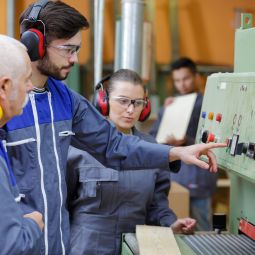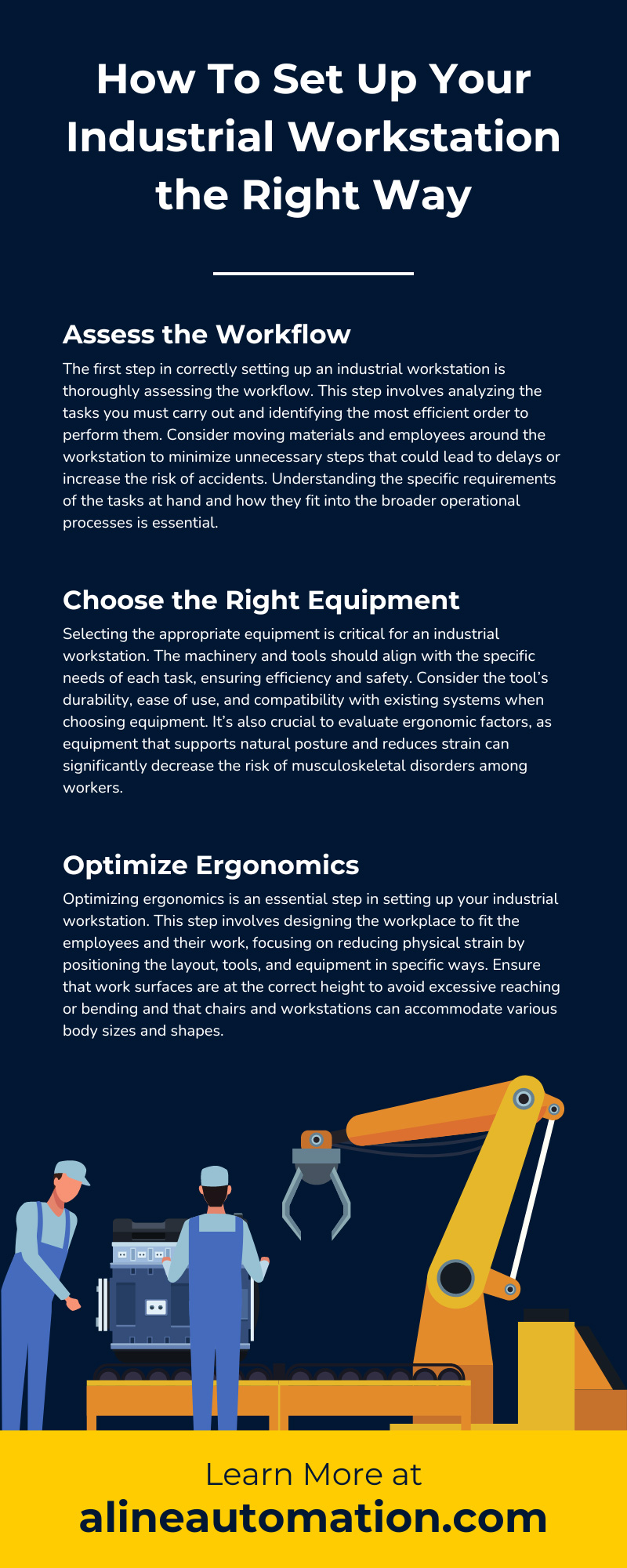
Setting up an industrial workstation requires meticulous planning and consideration of various factors to ensure safety, efficiency, and productivity. The design and organization of workstations play a crucial role in optimizing workflows, minimizing hazards, and enhancing employee well-being in the fast-paced environment of industrial operations. Learn how to set up your industrial workstation the right way and create a safe and productive working environment for your employees.
The first step in correctly setting up an industrial workstation is thoroughly assessing the workflow. This step involves analyzing the tasks you must carry out and identifying the most efficient order to perform them. Consider moving materials and employees around the workstation to minimize unnecessary steps that could lead to delays or increase the risk of accidents.
Understanding the specific requirements of the tasks at hand and how they fit into the broader operational processes is essential. This assessment will help determine the workstation’s optimal layout, ensuring that tools and materials are easily accessible and sufficient space for employees to work comfortably and safely. Streamlining the workflow can help you boost productivity and significantly reduce the potential for workplace injuries.
Selecting the appropriate equipment is critical for an industrial workstation. The machinery and tools should align with the specific needs of each task, ensuring efficiency and safety. Consider the tool’s durability, ease of use, and compatibility with existing systems when choosing equipment. It’s also crucial to evaluate ergonomic factors, as equipment that supports natural posture and reduces strain can significantly decrease the risk of musculoskeletal disorders among workers.
Additionally, investing in high-quality, reliable equipment may have a higher initial cost but can lead to long-term savings by reducing downtime and maintenance needs. Always stay informed about the latest technological advances in your industry, as innovative tools and machinery can offer new ways to enhance productivity and safety at your workstation.
Optimizing ergonomics is an essential step in setting up your industrial workstation. This step involves designing the workplace to fit the employees and their work, focusing on reducing physical strain by positioning the layout, tools, and equipment in specific ways. Ensure that work surfaces are at the correct height to avoid excessive reaching or bending and that chairs and workstations can accommodate various body sizes and shapes.
Providing anti-fatigue mats where necessary can also help reduce discomfort during long periods. Additionally, adequate lighting is crucial to prevent eye strain and improve visibility, contributing to task safety and efficiency. Prioritizing ergonomics allows you to support employee health and enhance productivity by minimizing the risk of injury and fatigue.
Implementing robust safety measures is the backbone of setting up an industrial workstation. This step begins with adhering strictly to all relevant safety regulations and standards, which may involve regular workstation audits and employee training sessions on safety practices. Installing safety equipment, such as emergency stop buttons, machine guards, and fire extinguishers, is non-negotiable. Ensure you correctly ground all machines and all electrical installations comply with safety standards to prevent accidents.
Clear signage should mark hazardous areas, and proper personal protective equipment (PPE) must be readily available for all employees. Businesses can significantly reduce the likelihood of workplace accidents while promoting a more productive and engaged workforce by fostering a safety culture prioritizing every worker’s well-being. Safety measures protect employees and safeguard the company’s assets and reputation.
Enhancing lighting and visibility in an industrial workstation is key to maximizing efficiency and ensuring safety. Good lighting reduces the risk of accidents by making it easier to spot potential hazards and perform tasks accurately, thus preventing mistakes that could lead to injuries or wasted resources. This task involves assessing the specific lighting needs for different jobs and incorporating various lighting solutions, such as overhead lighting for general visibility and task lighting for focused work areas.
You should utilize natural light wherever possible, as it boosts mood and productivity among employees. Additionally, reflective surfaces and high-visibility markings can help improve overall visibility within the workshop. You can enhance safety and contribute to a more vibrant and energized workplace atmosphere by creating a well-lit environment.
Organizing tools and materials is pivotal in maintaining an efficient industrial workstation. A well-organized workspace allows quick identification and access to necessary tools, minimizing downtime and improving productivity. Implement storage solutions that are both space-efficient and in a strategic location to maintain clear pathways and reduce clutter.
Utilize labeling and color-coding systems to simplify identification, ensuring every item has a designated place. Furthermore, regularly auditing tools and materials for condition and relevance can prevent accumulating unnecessary items that could hinder workflow. Companies can create a streamlined environment that fosters ease of operation and enhances overall performance by investing in smart organizational practices. Remember, an organized workstation is a productive workstation.
Promoting cleanliness and routine maintenance is crucial for the longevity of equipment and the smooth operation of an industrial workstation. A clean workspace reduces the risk of accidents by eliminating potential hazards and instills a sense of professionalism and pride among employees.
Implement a regular cleaning schedule, emphasizing the importance of keeping the workstation clutter-free and the equipment dust and debris-free. Additionally, you must establish a maintenance routine for all machinery and tools, including regular inspections and timely repairs, to prevent breakdowns and extend their lifespan. Encouraging employees to report any issues immediately can also mitigate larger problems. Businesses can ensure a safer, more efficient, and productive working environment by emphasizing cleanliness and maintenance.
Learning how to set up your industrial workstation the right way is a comprehensive process involving meticulous planning and execution across various domains. Each step is critical for creating a safe and productive industrial environment, from assessing workflows, choosing the right equipment, optimizing ergonomics, implementing safety measures, enhancing lighting and visibility, and organizing tools and materials to promoting cleanliness and maintenance. Businesses can ensure their employees’ well-being and efficiency and position themselves for greater productivity and success in their industrial operations by following these guidelines.
A-Line Automation can help if you need an aluminum work table for your industrial workstation. Our high-quality, durable work tables are perfect for various industrial applications. Visit our website to learn more about our products or contact us for a customized solution that meets your specific requirements.
